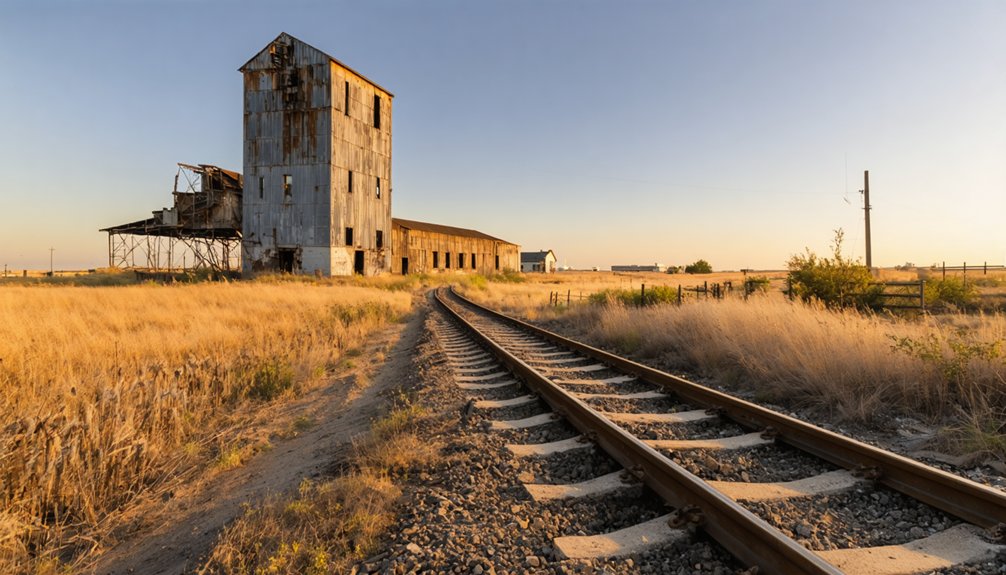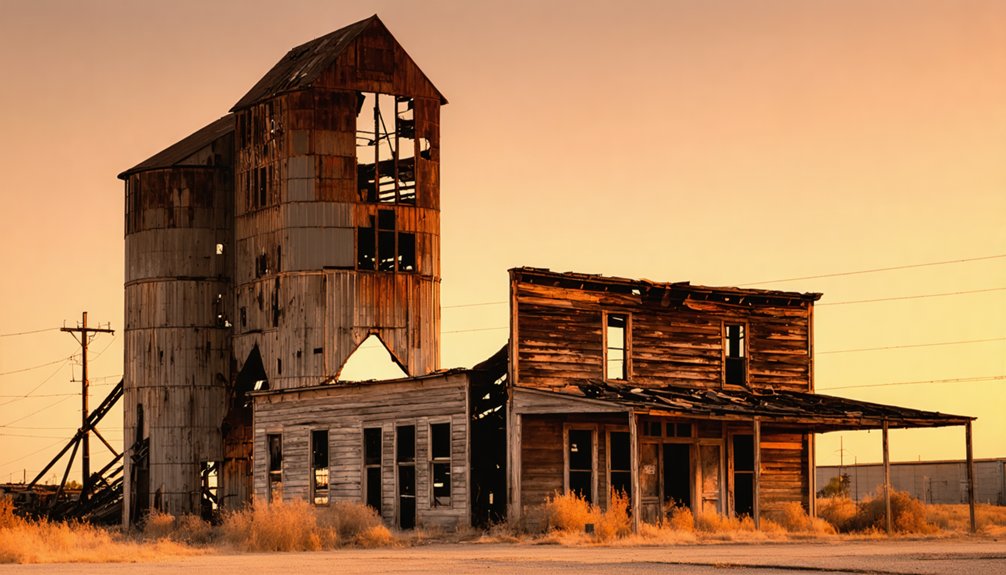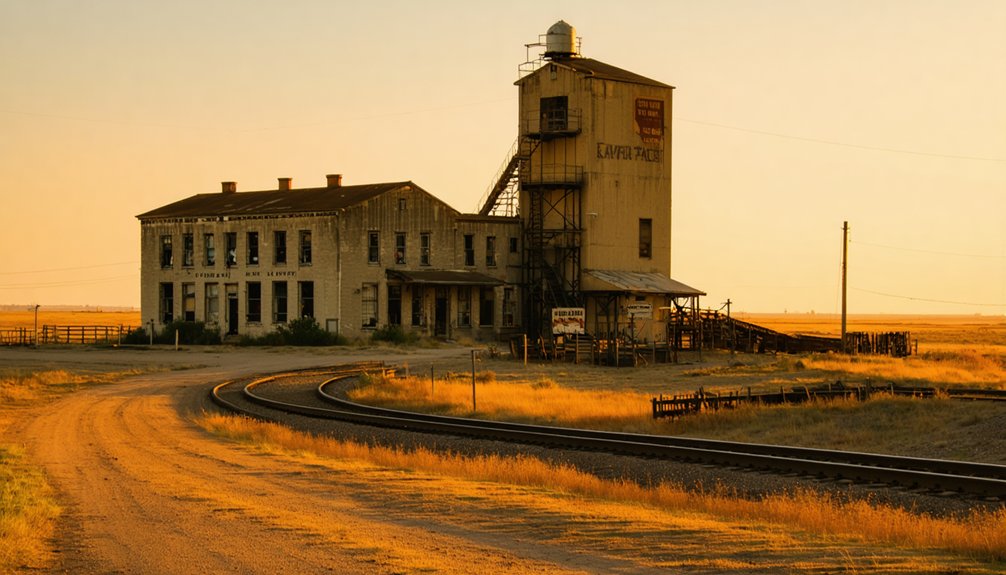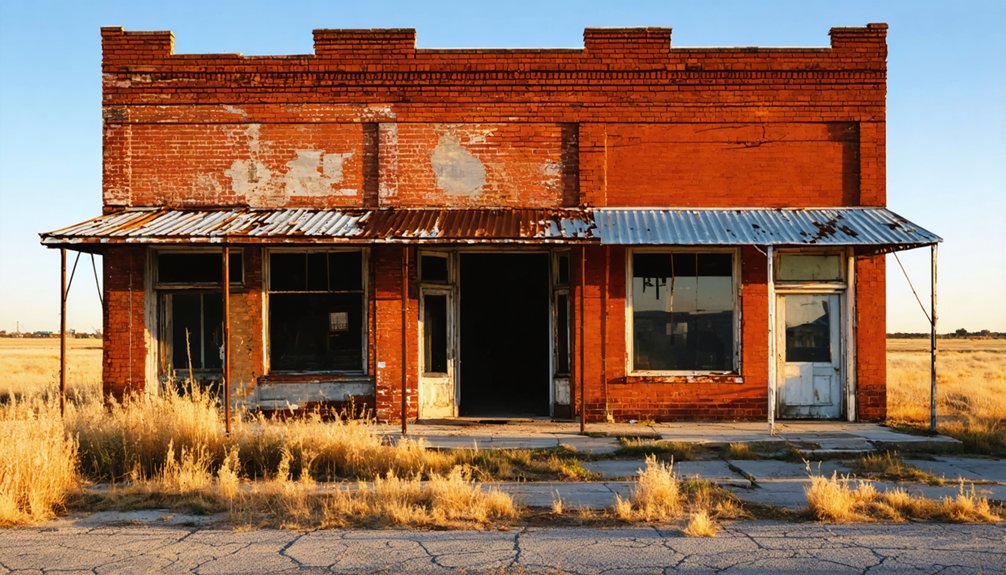You’ll find Plemons in Hutchinson County, Texas, where it began as a Canadian River crossing point in 1898. James Whittenburg established the settlement, which grew into the county seat by 1901. Despite its early success with Dixon’s hotel and Plemons’ reliable river crossing service, the town declined after losing its county seat status in 1926. Today, only the historic cemetery remains, marking a fascinating chapter of frontier life that’s waiting to be discovered.
Key Takeaways
- Plemons was established in 1898 as a river crossing settlement in Hutchinson County, Texas, serving as a vital point for ranchers and travelers.
- The town briefly served as Hutchinson County’s seat until 1926, featuring a courthouse, post office, and Billy Dixon’s boarding house.
- Despite early prosperity, Plemons declined after being bypassed by railroads and losing its county seat status to Stinnett.
- A 1932 bank robbery by W.J. “Shine” Popejoy marked one of the final significant events in the town’s history.
- Today, only the historic cemetery remains of the original town, with the last burial occurring in 1953.
The Birth of a River Crossing Settlement
While the Canadian River wound its way through the Texas Panhandle, an essential settlement emerged at one of its safer crossing points in central Hutchinson County.
You’ll find Plemons geography defined by its strategic location at a river bend, where quicksand proved less treacherous than other crossing spots.
In 1898, Oklahoma rancher James Andrew Whittenburg recognized the location’s potential and built a dugout shelter into the natural hills.
The site’s proximity to major ranches like Turkey Track and Tar Box guaranteed steady traffic.
Early agriculture wasn’t the focus in this semiarid region – instead, the settlement thrived on providing safe passage across the river.
Unlike farming-focused frontier towns, this outpost’s lifeline was guiding travelers safely across treacherous waters in Texas’s harsh landscape.
When Barney Plemons established his crossing service, complete with a legendary horse that could detect quicksand, the settlement’s future was secured.
The area quickly developed into a bustling hub as shops and settlers were drawn to the successful crossing business.
Like many disambiguation entries in Wikipedia, the place name Plemons would later refer to multiple locations in Texas history.
Life in Early Plemons (1898-1901)
You’d find James A. Whittenburg‘s dugout home marking the first sign of settlement in 1898, as he worked to establish his ranching operations in this remote area of Hutchinson County.
Early settlers faced significant challenges in developing the necessary infrastructure, though the establishment of essential buildings began taking shape, including homes for the initial 15 families who joined the community. William Dixon operated the town’s only hotel for three years.
The town would later serve as the county seat before ultimately declining into a ghost town with only a small cemetery remaining today.
River Crossing Commerce
During the late 1890s, Plemons emerged as an indispensable crossing point over the Canadian River, where a natural river bend provided safer passage for travelers and merchants.
You’d find Barney Plemons’ trusted horse detecting dangerous quicksand, making river trade significantly safer for those crossing through the region.
The settlement dynamics quickly took shape around this strategic location.
You’ll notice how the river crossing attracted merchants and ranchers from nearby Turkey Track and Tar Box operations.
Billy Dixon’s boarding house served weary travelers, while Mattie Sams’ post office, established in 1901, connected the growing community.
James Andrew Whittenburg’s dugout shelter marked the beginning of permanent settlement, and E. E. Akers’ courthouse construction cemented Plemons’ status as a crucial commercial hub in Hutchinson County.
Early Settlement Challenges
As James Andrew Whittenburg established Plemons in 1898 with a simple dugout shelter near the Canadian River, early settlers faced formidable challenges in the harsh Texas Panhandle environment.
You’d find only about 15 families displaying remarkable settler resilience during the first decade, building their own dugouts and basic structures in this isolated frontier location.
Agricultural struggles were constant, as the semi-arid climate made both farming and ranching difficult.
You couldn’t count on easy access to supplies, and the Canadian River was a double-edged sword – providing essential water but threatening with floods and treacherous quicksand.
Daily life meant dealing with limited resources, primitive living conditions, and the constant battle against nature.
The closest trading posts were distant, and you’d need to carefully plan your supply runs.
First Buildings Take Shape
The transformation of Plemons from a simple river crossing to a bustling frontier town began in 1898 with James A. Whittenburg’s construction of a dugout near the Canadian River’s bend.
You’d have witnessed the town’s rapid evolution as more settlers recognized the site’s potential, drawn by Barney Plemons’ successful river crossing business that helped travelers navigate treacherous quicksand.
Using his horse’s uncanny ability to detect unsafe terrain, Barney guided travelers safely across the hazardous Canadian River crossings.
As the community grew, basic building materials were used to construct the town’s first permanent structures.
For those studying the town’s history today, historical preservation efforts have made these early records accessible through digital archives.
By 1901, you’d have seen shops and homes taking shape, their architectural styles reflecting the practical needs of frontier life.
The establishment of the post office that May marked a significant milestone, and when Plemons became the county seat, additional administrative buildings emerged to serve the growing population’s needs.
Rise to County Seat Status
Establishment of Hutchinson County in 1901 marked Plemons’ official designation as the county seat. The town’s early governance took shape quickly, with E.E. Akers constructing the first courthouse to handle county business. The county was named after pioneer jurist Anderson Hutchinson.
You’d find the legendary frontier scout Billy Dixon serving as the county’s first sheriff after relocating from Adobe Walls.
- A two-story courthouse stood as a symbol of Plemons’ authority
- A post office opened with Mattie Sams as the first postmaster
- The local school employed two teachers to educate area children
- About 15 families called Plemons home in its first decade
The town’s early infrastructure established it as a regional center of power, though its population remained relatively modest compared to later boomtowns in the region. In 1922, Joe Ownbey was elected sheriff and tax collector, serving during a transformative period in the county’s history.
Economic Growth and Development

Plemons’ economic story began at a strategic crossing point on the Canadian River, where Barney Plemons established a significant passageway for cattle drives and travelers.
You’d find early economic sustainability through the crossing business, supported by nearby Turkey Track and Tar Box ranches that brought steady commerce to the area.
When Plemons became the county seat in 1901, you’d see community resilience grow as government workers and legal professionals moved in. The town celebrated its new status with a two-story courthouse that served as a symbol of progress.
The town developed vital services – a wagon yard, barbershop, doctor’s office, drugstore, and mercantile store. Like many boom and bust cycles that shaped Texas towns, Plemons experienced rapid growth followed by decline.
But the railroad’s decision to bypass Plemons dealt a crushing blow to its future. Even a brief oil boom couldn’t save the town’s economy.
Notable Residents and Their Stories
You’ll find that Plemons’ most notorious resident was W.J. “Shine” Popejoy, known as the “King of Texas Bootleggers,” who robbed the town bank in 1932 and maintained ties to Borger’s criminal underworld.
The town’s early development centered around William Buford Plemons, a Confederate veteran turned judge who helped establish the settlement, and James A. Whittenburg, whose 1898 dugout overlooking the Canadian River marked the community’s first permanent structure.
While law enforcement struggled to maintain order during the oil boom years, evidence of their presence remains in one of the town’s few surviving structures – the old jail building.
Frontier Law and Order
As lawlessness spread across the Texas frontier in the late 1800s, the Texas Rangers emerged as a powerful force near Plemons and throughout the region.
You’ll find their presence was essential in maintaining law enforcement during an era of rampant criminal activity, from train robberies to cattle rustling. The Rangers, reorganized into smaller companies after 1901, tackled increasing violence with determined precision.
- Major John B. Jones’s Frontier Battalion specifically targeted outlaws in West Texas
- Notable Rangers like A.Y. Baker patrolled the Plemons vicinity, combating local criminal gangs
- John Wesley Hardin, responsible for 31 kills, was eventually captured by Ranger John B. Armstrong
- During the Mexican Revolution, Rangers faced intense border violence, often taking harsh measures to restore order
Dixon’s Boarding House Legacy
While the Texas Rangers maintained law and order across the frontier, another form of stability emerged through William “Billy” Dixon’s boarding house in Plemons.
Dixon’s influence extended beyond his role as the first county sheriff, as his establishment became a crucial community hub for nearly three years. You’ll find that the boarding house community included both travelers and local workers, particularly those connected to the Turkey Track and Tar Box ranches.
Dixon, a former buffalo hunter and scout, managed to balance his law enforcement duties while providing essential hospitality services. The boarding house’s significance grew through its connection to other community institutions, like the local Masonic lodge, where Dixon was an active participant.
His family’s legacy continued through descendants who spread throughout West Texas.
Sams’ Postal Service Years
When the Plemons post office opened its doors on May 29, 1901, Mattie Sams stepped into her pioneering role as the town’s first postmaster.
Her leadership in postal innovation helped transform Plemons from a scattered settlement into a functioning frontier community.
You’ll find Mattie Sams’ impact reflected in these key achievements:
- Established reliable mail service for 15 pioneer families during the town’s earliest days
- Created a crucial communication hub that connected isolated ranches to the outside world
- Maintained consistent postal operations through the town’s peak growth years
- Served as a cornerstone of civic life alongside the school and general store
Her dedicated service continued through the significant period of the town’s development, making the post office a symbol of stability until its closure in 1952.
The Infamous 1932 Bank Robbery
The sleepy town of Plemons, Texas witnessed one of its most dramatic moments on March 18, 1932, when notorious bootlegger W. J. “Shine” Popejoy stormed the local bank.
Known as the “king of Texas bootleggers,” Popejoy’s notoriety grew even larger after this bold heist, which highlighted the vulnerability of rural banks during the Great Depression.
The robbery itself was straightforward – Popejoy forced his way in and demanded cash from bank staff.
While the exact amount stolen remains unclear, the incident left an indelible mark on Plemons’ history.
This act of rural crime came during the town’s decline toward ghost town status, symbolizing the era’s lawlessness.
The robbery added a fascinating chapter to Plemons’ legacy and exemplified the wave of Depression-era bank heists sweeping across Texas’ frontier communities.
Factors Leading to the Town’s Decline

Multiple forces converged to transform Plemons from a thriving frontier town into a ghost town by the mid-20th century.
Transportation shifts dealt the first blow when the Amarillo branch line bypassed the town, causing businesses to relocate to railroad-connected areas.
Political changes followed in 1926 when Plemons lost its county seat status, further diminishing its importance.
The town’s isolation from the region’s oil boom and declining cattle industry sealed its fate.
- You would’ve witnessed businesses shuttering as commerce shifted to neighboring rail towns
- The courthouse’s relocation stripped away government jobs and services
- Your neighbors likely moved away as the school and post office closed by 1952
- If you’d stayed, you’d have seen most buildings razed or left to decay
What Remains Today
Modern visitors to Plemons will find little evidence of its frontier past, as virtually nothing remains of this once-bustling town in Hutchinson County, Texas.
All buildings, including the prominent two-story brick school and post office, have been completely razed by the property’s current owner.
The only physical remnant you’ll find is the historic cemetery, where the last burial took place in 1953.
You can’t simply walk in, though – cemetery access requires advance permission and a phone call to the landowner.
Among the graves, you’ll find poignant reminders of the town’s history, including children’s tombstones and victims of a local epidemic.
While the structures are gone, folklore legends persist, including tales of a hermit snake catcher and the famous Texas panhandle hero, William “Billy” Dixon.
Legacy in Texas Panhandle History

While physical traces of Plemons have largely vanished, its enduring influence on Texas Panhandle development remains evident in regional history. The town’s cultural significance extends beyond its physical structures, reflecting the community resilience that characterized early Texas frontier settlements.
- You’ll find Plemons’ story mirroring many Texas Panhandle communities that rose and fell with changing transportation needs and county politics.
- The town’s legacy lives on through its pioneering role in establishing crucial river crossings and early governance structures.
- Plemons’ history showcases the determination of early settlers who built thriving communities in challenging frontier conditions.
- Its transformation from county seat to ghost town serves as a powerful reminder of how economic and political shifts shaped the region’s development.
Frequently Asked Questions
What Was the Highest Recorded Population of Plemons During Its Peak?
You’ll find that 150 people marked Plemons’ highest documented population during its early peak, before its dramatic population decline when the county seat moved to Stinnett, which quickly grew to 2,500 residents.
Were There Any Native American Settlements Near Plemons Before Its Founding?
You’ll find extensive Native settlements along the Canadian River near Plemons, including the Antelope Creek culture’s multi-story dwellings from 1200-1450 AD, showcasing the area’s rich cultural significance.
What Happened to the Original Buildings When Residents Left Plemons?
Over 90% of original structures became abandoned relics before collapsing. You’d find most buildings were eventually bulldozed and buried by the new landowner who purchased the property and restricted access.
Did Any Movies or Television Shows Ever Feature Plemons?
You won’t find Plemons featured in any known movies or TV shows, though its fascinating history and folklore about outlaws and quicksand would make compelling material for Western or documentary productions.
Are There Any Annual Events or Reunions Held to Commemorate Plemons?
Like footprints in desert sand, Plemons history fades without formal gatherings. You won’t find any annual events or Ghost town events commemorating this place – no regular reunions keep its memory alive.
References
- https://mix941kmxj.com/the-strange-sad-story-of-a-texas-ghost-town-youll-never-visit/
- https://www.legendsofamerica.com/tx-hutchinsonghosttowns/
- https://en.wikipedia.org/wiki/Plemons
- https://www.ghosttowns.com/states/tx/plemons.html
- https://www.allacrosstexas.com/texas-ghost-town.php?city=Plemons
- https://www.tshaonline.org/handbook/entries/plemons-tx
- https://www.texasescapes.com/TexasPanhandleTowns/Plemons-Texas.htm
- https://halseybrooks.com/txhutchi/towns2.html
- https://texashistory.unt.edu/ark:/67531/metapth20204/m1/236/
- https://www.hmdb.org/m.asp?m=93254



